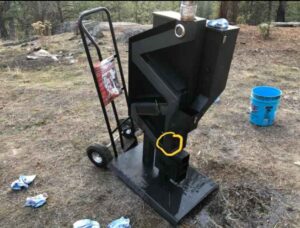Picture this: it’s freezing outside, and the power’s gone out. You need a reliable, easy-to-use heating solution that doesn’t depend on electricity. That’s when a gravity-fed wood pellet stove comes into play. These stoves use a natural gravity feed system to burn wood pellets and produce heat, making them perfect for off-grid living or as a backup during power outages.
What Is a Gravity-Fed Wood Pellet Stove?
Gravity-fed wood pellet stoves rely on the natural force of gravity to feed pellets from a hopper into the burn chamber. Unlike electric pellet stoves, they don’t need motors or fans to operate, which means:
- No Electricity Needed: Operates without power, making it ideal for remote areas or power outage situations.
- Simple Operation: Fewer moving parts mean less maintenance and easier troubleshooting.
- Consistent Heat Output: Provides steady and even heating with minimal intervention.
- Compact and Efficient: Perfect for smaller spaces like cabins, RVs, tiny homes, or workshops.
Top Gravity-Fed Wood Pellet Stoves on the Market
To help you choose the best gravity-fed wood pellet stove, I’ve compiled a list of the top options based on efficiency, ease of use, build quality, and real-world performance.
1. Wiseway GW1949 Non-Electric Pellet Stove

The Wiseway GW1949 is hands down one of the most reliable gravity-fed pellet stoves out there. I’ve seen this one keep a cabin cozy through a rough winter without breaking a sweat.
- BTU Output: 40,000 BTU, suitable for heating spaces up to 2,000 sq. ft.
- Burn Time: Up to 36 hours on a full load.
- Design: Vertical, sleek design that doesn’t take up much floor space.
- Special Features: Fully non-electric; no moving parts, so there’s virtually nothing that can break.
- Pros: Extremely efficient, quiet, long burn time, and easy to operate.
- Cons: Steep learning curve to master the airflow adjustments; heavy at 131 lbs.
The Wiseway GW1949 is great if you want something powerful and reliable. It’s especially suited for off-grid homes or areas where power outages are common. Once you get the hang of adjusting it, you’ll love the steady warmth it provides.
2. Clarry Portable Gravity-Fed Pellet Stove
The Clarry Pellet Stove is perfect if you’re looking for a more compact and portable option. This stove is particularly popular among those who need flexibility and ease of use.
- BTU Output: Up to 30,000 BTU, great for spaces around 1,500 sq. ft.
- Burn Time: 12 to 24 hours, depending on pellet feed rate and burn settings.
- Design: Compact and freestanding, making it easy to move and install.
- Special Features: Lightweight and versatile, easy to transport and set up.
- Pros: Portable, adjustable burn rate, and easy to use.
- Cons: Smaller hopper requires more frequent refilling; less suitable for larger spaces.
For anyone who needs a lightweight and portable solution, the Clarry Pellet Stove is a fantastic choice. It’s especially useful for smaller spaces and temporary setups, like hunting lodges or RV trips.
3. Vogelzang VG5770 Slimline Pellet Stove
While not as purely gravity-fed as some others, the Vogelzang VG5770 still operates without electricity in certain modes, making it a solid contender for small spaces and budget-conscious buyers.
- BTU Output: 48,000 BTU, suitable for spaces up to 2,200 sq. ft.
- Burn Time: Up to 60 hours, depending on settings and pellet quality.
- Design: Slim and compact, making it a great fit for tighter spaces.
- Special Features: Semi-gravity fed with an efficient burn chamber and adjustable heat settings.
- Pros: High heat output, long burn time, and good value for money.
- Cons: Not fully gravity-fed; relies partially on electricity for optimal performance.
The Vogelzang VG5770 is a great compromise for those who want both the efficiency of a pellet stove and the flexibility to use it in various modes.
Key Features to Consider When Choosing a Gravity-Fed Pellet Stove
- Heat Output (BTU): Ensure the stove’s BTU rating matches the size of the space you need to heat.
- Burn Time: Longer burn times mean less refilling and more continuous heat.
- Size and Portability: Consider the size of the stove and whether it needs to be moved frequently.
- Ease of Use: Look for stoves with straightforward controls and a minimal learning curve.
- Material and Build Quality: Ensure the stove is made from high-quality materials like steel or cast iron for durability.
- Safety Features: Consider stoves with built-in safety features like a hopper lid sensor or an automatic shut-off.
Tips for Getting the Most Out of Your Gravity-Fed Pellet Stove
- Regular Cleaning: Clean the burn pot and ash pan regularly to maintain efficiency and reduce the risk of malfunction.
- Use High-Quality Pellets: High-quality pellets burn cleaner and longer, reducing maintenance needs and increasing efficiency.
- Adjust for Optimal Burn Rate: Find the right balance of airflow and feed rate for your specific space and needs.
- Ensure Proper Venting: Make sure the stove is vented properly to avoid smoke buildup and enhance safety.
Conclusion
When it comes to finding the best gravity-fed wood pellet stove, the Wiseway GW1949 remains a standout for its non-electric operation, efficiency, and build quality. However, the Clarry Pellet Stove offers a more portable solution for those who need flexibility, while the Vogelzang VG5770 provides a blend of high heat output and value.
Choose based on your specific needs—whether it’s off-grid living, emergency backup heating, or something versatile for different spaces. Maintain it well, use quality pellets, and enjoy the reliable warmth all winter long!
